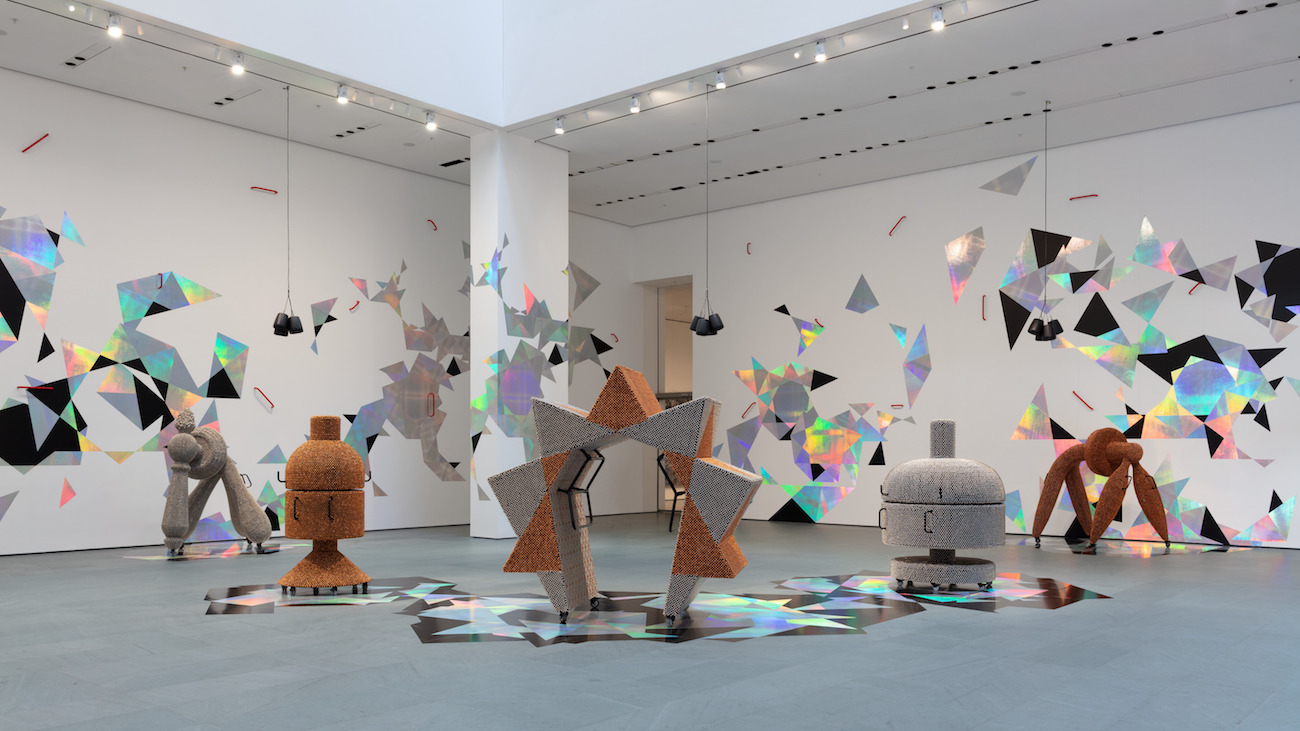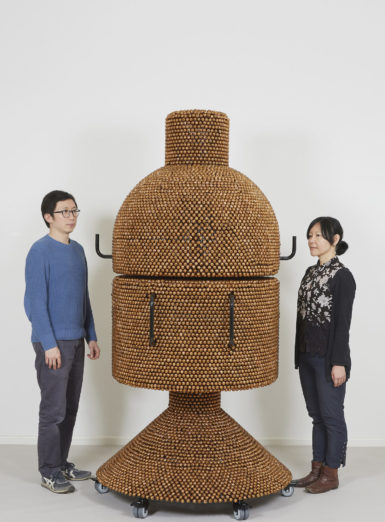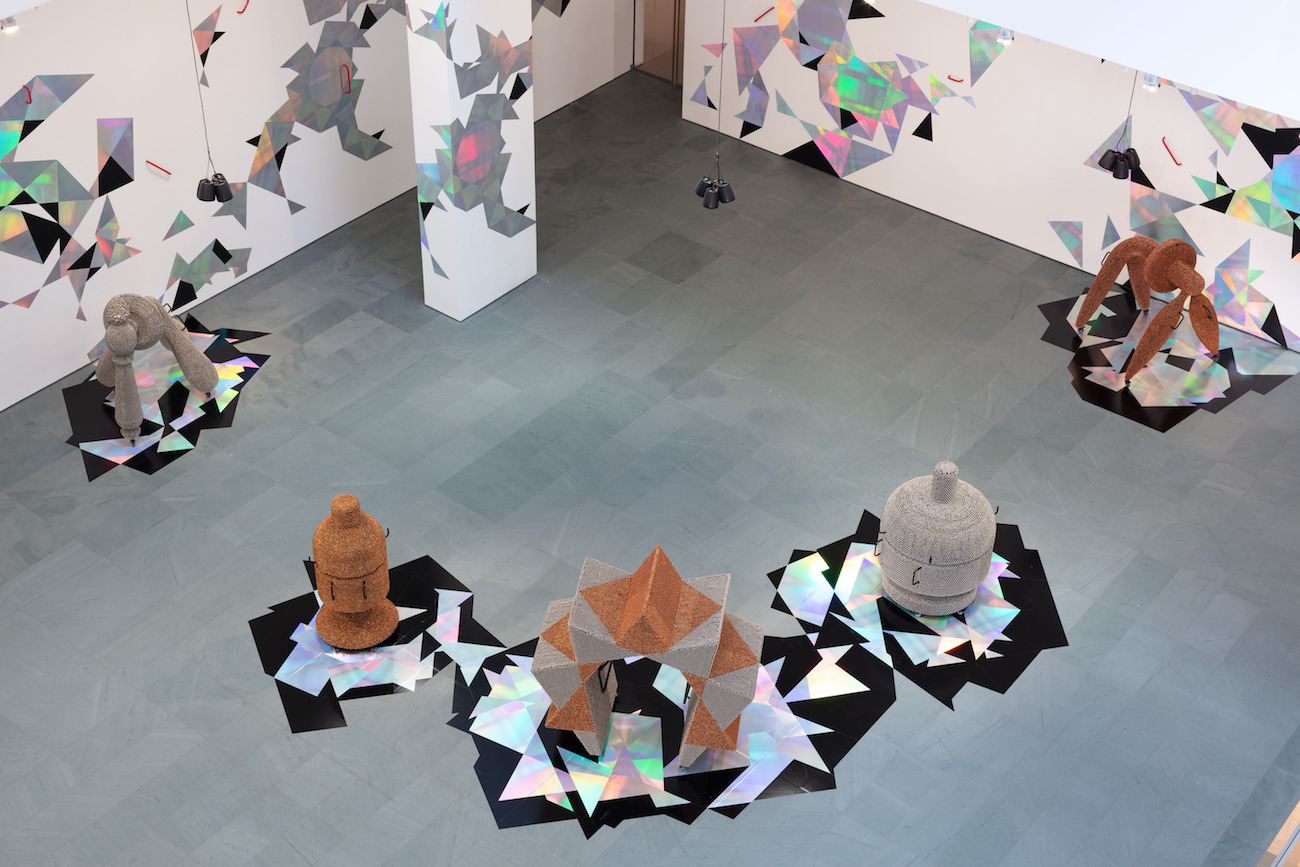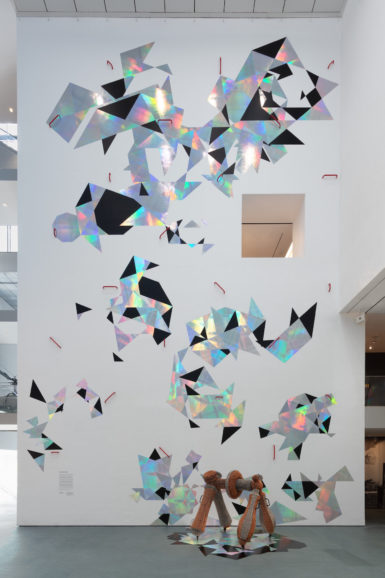[ad_1]

Installation view of Haegue Yang: Handles commissioned by MoMA for the Marron Atrium.
DENIS DOORLY
When visitors enter the Museum of Modern Art’s atrium, which remains one of the grandest spaces in the newly renovated institution, the more imaginative among them might be struck by the sensation of hanging high above, white-knuckled somewhere in the midst of the 60 feet separating the ceiling and a mysterious arrangement of artworks below. Climbing is not encouraged (or even really possible), but the idea of doing so is integral to Handles, a new installation of sculptures and sound made on commission by South Korea–born, Berlin-based artist Haegue Yang.
“Often I don’t know how to make the story shorter—it might be a kind of semi-long story,” Yang said when asked what connects all the installation’s elements, which include handles of a kind used in industrial design, shimmery vinyl patterns on the walls, the sounds of birds and experimental music, and large wheeled sculptures covered with bells. The 48-year-old artist was at MoMA installing a couple weeks ago, with construction sounds all around her but a sense of serenity and focus in the central atrium area that greets museumgoers at the start of their journey.
Organized by Stuart Comer, MoMA’s chief curator of media and performance, the installation draws interconnecting lines between aspects of Yang’s work as an exploratory sculptor and histories forged and fortified by MoMA itself. Its centerpieces are six large sculptures that can swerve and spin—as they will when activated by performers every afternoon, starting when the museum reopens to the public on October 21—while paying tribute to one of the work’s many allusions: the polymathic artist Sophie Taeuber-Arp.
“She started her career as a dancer at the first Dada exhibitions in Zurich,” Yang said, “and then she was a painter, sculpture, educator, architect, interior designer. Did I forget anything? Weaver—she was also a weaver.”

Haegue Yang’s Sonic Coupe Copper – Enclosed Unity from “Handles.”
©HAEGUE YANG/COURTESY STUDIO HAEGUE YANG
The shapes of the sculptures evoke Taeuber-Arp works like Coupe Dada (1916), a wooden totem that suggests various sorts of usefulness while keeping its true purpose a secret. “They’re very mysterious and spiritual,” Yang said. “They appear a bit religious and feministic somehow, because of the forms and what she embodied.” (“They look utilitarian,” Comer added, “but they’re not.”)
Mystery and multivalence are also qualities of another inspiration: George Ivanovich Gurdjieff, an Armenian mystic whose many interests in the early 20th century included elusive states of consciousness and forms of movement meant to conjure them. “He was a figure who had a kind of shapelessness,” Yang said. “People would often ask him, ‘Who on Earth are you?’ And he often answered, ‘I’m a teacher of dance.’” (Yang named a 2011 survey of her work at Modern Art Oxford in England “Teacher of Dance.”)
Gurdjieff will be channeled when the sculptures at MoMA move each day for one hour starting at 4 p.m., as performers take to the space and push two of the works around in a sort of improvised dance. (“They need a lot of space to move,” Yang said. “Two is a good amount: they can chase each other, they can cross each other. Three makes for too much limitation of movement.”) The paths they follow will have spiritual matters in mind. “Gurdjieff dances are very introverted, but they build community,” the artist said. “They’re attuned within an environment, abstract but very concrete.”
As the sculptures are mobilized, hundreds of bells covering them will sound—but in a subtle manner meant to evoke shamanistic rites. “The first thing people do with bells is shake them, but we use bells in the sculptures as a tracer of what we know from ritualistic ceremonies,” Yang said. Shamanism has been deeply embedded in Korea dating back to prehistoric times, and Comer said the connection is crucial. “In almost every reference in this work there’s dialogue between a very machine-oriented West and a shamanistic East.” Of the soft sound the sculptures make, he added, “It’s almost like a shadow of the bells—they’re there, but as a quiet echo of very old shamanistic traditions.”

Installation view of Haegue Yang: Handles commissioned by MoMA for the Marron Atrium.
DENIS DOORLY
Allusions to East and West figure into another reference point: Isang Yun, a Korean composer whose 1968 ensemble work Images (for flute, oboe, violin, and cello) will be broadcast in MoMA’s atrium every afternoon for 20 minutes near the end of the sculptures’ activation. “As a South Korean, you know his name,” Yang said of the musician, “but why he is known is because of his biography, having been accused of being a North Korean spy. He’s very debated as a figure. I was one of these hundreds of thousands of people in Korea who knew his name, but I was struck by the fact that I didn’t know his music.”
After being imprisoned and tortured for espionage, Yun lived in Germany later in life and—like another Korea-born artist, Nam June Paik—made his most notable work in the West. “This segregation or separation—or amputation—between his musical life and political life divided into different continents,” Yang said. “His musical legacy is bound to the old European continent, but his political reputation is still very much strangled around the Korean peninsula. This segregation I was interested in.”

Installation view of Haegue Yang: Handles commissioned by MoMA for the Marron Atrium.
DENIS DOORLY
A desire to reconcile such tensions—or at least acknowledge them—is key to Handles, which Yang said aspires to be “a kind of mapping of time and places that are normally not neighbors.” Such mapping is embodied in sound that will play in the atrium all day long: recordings of birds chirping during a summit between North and South Korea in 2018. (The birdsongs were captured by journalists who tried to record private conversation between leaders but wound up instead with only ambient sounds.)
But mapping also applies more figuratively—to the act of making connections between disparate interests. “If you look through into the galleries,” Comer said of other artwork hanging in the museum nearby, “there’s a giant painting by Jack Whitten that’s an homage to Édouard Glissant. [Yang’s art] is very much a kind of Glissant model of thought: the idea of archipelagos of difference where all these singularities are brought together into a whole that also respects individual difference.”
The setting serves up significance too. “One thing I don’t think she was conscious of but that I can’t help but read,” Comer said, “are connections to early shows at MoMA, especially the ‘Machine Art’ show”—a prescient exhibition that focused on utilitarian industrial objects in 1934. “There are lots of weird echoes with early chapters of modernism and, again, a binary between man and machine that was so present in MoMA’s early program. Here we are in a post-industrial moment 90 years later and it feels like there are aspects of [Yang’s] work that are incredibly futuristic and forward-looking and then others that are about recuperating previous forms and rethinking them.”
One new embodiment of Yang’s thinking are the “handles” that figure in the show’s title and feature on the sculptures as well as on the walls rising up from the floor. Interspersed among silver vinyl shapes that refract prismatic light depending on a viewer’s perspective (another reference to Gurdjieff), red handles on the walls look like climbing aids but cannot quite be reached. Elusiveness is part of the point, Yang said, but more important is what handles have come to represent for her. “Handles can be an enabler, translator, operator. A handle enables something but deletes itself. A handle is never the focus.”
Comer called them “a conduit to something else,” and that something else is what intrigues Yang most. “By deleting itself,” she said, “a handle opens up the possibility of connections between things.”
[ad_2]
Source link

